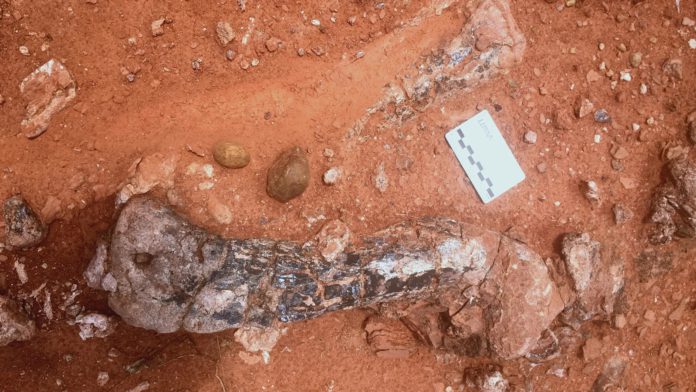Fossils found on the shoreline of Lake Kariba in Zimbabwe belong to a brand-new species of dinosaurs – not previously known to science – say an international team of scientists.
The new dinosaur – named Musankwa sanyatiensis – was a member of the Sauropodomorpha, a group of bipedal, long-necked dinosaurs that were widespread during the Late Triassic period, approximately 210 million years.
Weighing in at around 390 kg, the plant-eating Musankwa sanyatiensis would have been one of the larger dinosaurs of its era.
“Despite the limited fossil material, these bones possess unique features that distinguish them from those of other dinosaurs living at the same time,” says Dr Kimberley ‘Kimi’ Chapelle, assistant professor at Stony Brook University and an honorary associate at the Evolutionary Studies Institute at Wits.
The international team consisted of scientists from the University of the Witwatersrand, the Natural History Museum of Zimbabwe, Stony Brook University in New York and the Natural History Museum in London.

Natural History Museum palaeontologist, Prof. Paul Barrett who was leading the research said: “We were walking along the shoreline when I noticed these leg bones eroding out of the ground. After we excavated the fossils, we realised it was quite different from the dinosaurs you might expect to find in the area.
“This species is pretty old, dating back to the Late Triassic when the dinosaurs were getting larger and starting to dominate ecosystems. This is the time when they began to become more diverse and spread around the world, making it an important era to investigate.”
The research detailing this significant discovery is set to be published in the journal Acta Palaeontologica Polonica.
Africa has a long history of dinosaur discovery, with the first dinosaur in the southern hemisphere found in South Africa just three years after the term “dinosaur” was coined by Sir Richard Owen in 1842. However, most known dinosaur fossils have been found in just 10 countries, particularly in the northern hemisphere, leading to a sparse representation of African dinosaur diversity in the global fossil record.


